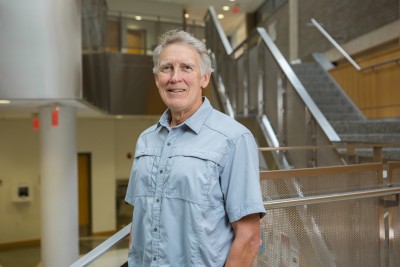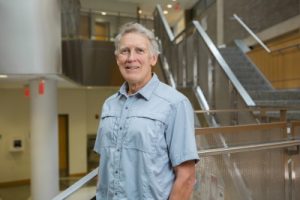A. John Gatz was born in the suburbs of Chicago and developed an early passion for animals while visiting the Brookfield and Lincoln Park Zoos and hiking in the local forest preserve. After his family moved to Augusta, Georgia, his fascination with biology continued while roaming the countryside collecting insects and otherwise enjoying nature. John left Georgia for Dickinson College in Carlisle, Pennsylvania, where he graduated with honors in biology. His honors research on spotted salamanders culminated in a couple of his earliest publications. He spent his college summers at the Chesapeake Biological Laboratory researching the effects of heated discharge water from electric power stations on estuarine organisms. John continued his education at Duke University, where he was first a teaching assistant and then an instructor. His time at Duke was interrupted by his active duty service as a combat engineer in the U.S. Army Corps of Engineers. He returned to Duke to complete his dissertation on the ecology of stream fishes in North Carolina; his publications from this research on the ecomorphology of fishes are still widely cited internationally today.
Directly after earning his Ph.D., John came to Ohio Wesleyan University, where he was hired to teach courses in ecology, comparative anatomy, and an introductory course for non-majors. By his third year here, he added “Evolution” to his teaching in response to student requests and also went to the Galapagos Islands for the first time. Later he joined the rotation of faculty teaching “Island Biology” and took groups of students to the Galapagos multiple times between 1979 and 2015. In 1983, John developed and taught a new and unique Travel-Learning Course, “Biology of East Africa,” and took students to Kenya. Now through The OWU Connection program, John has taught the course multiple times and taken nearly 50 students to Tanzania. Multiple prospective students who ultimately matriculated at Ohio Wesleyan cited their visit to this course as heavily influencing their decision (classroom sessions that included visits by cheetah cubs from the Columbus Zoo helped). John started teaching his newest course, “Human Anatomy,” so that students interested in a variety of advanced health professions could complete their required courses at OWU. Besides these regular courses, John also led a variety of seminars associated with the National Colloquium in its early years and a wide diversity of departmental seminars.
While at Ohio Wesleyan, John has continued research in multiple areas and supervised undergraduates both during the academic year and in the summer. This work has culminated in papers – many coauthored with students – related to sexual selection in frogs and toads, movement and homing in stream fishes, effects of electroshocking on fishes, foraging behavior of beavers, using the Index of Biotic Integrity for the Delaware Run that flows through campus, and the morphology of lizards. Additional publications grew out of data sets gathered as part of the ecology course he taught for many decades. In addition to this local research, he served as a visiting faculty member in the Oak Ridge Science Semester Program and intermittently did research associated with the Environmental Sciences Division at Oak Ridge National Laboratory. These years culminated additional publications on the ecology of fishes.
Beyond his teaching and research at Ohio Wesleyan, John has been heavily involved in our faculty governance system. He chaired the Zoology Department for several terms. John served on multiple standing committees of the faculty, and ultimately chaired most of those on which he served. These included both the Academic Status Committee and Academic Policy Committee, and also the Faculty Personnel Committee, a committee on which he served nearly a decade and chaired most of those years. For the past nine years, he has been the Chief Health Professions Advisor and has helped guide numerous students in their quests to gain acceptance into medical school, dental school, or other health professional programs.
Outside of Ohio Wesleyan, John prefers activities that keep him active and outdoors. He has completed 20 marathons, pedaled more than 55,000 miles on his current bicycle, kayaks regularly in the summers, and enjoys visiting and hiking in state and national parks with his wife, Tami, sons, David (OWU 2010) and Michael (OWU 2012), and daughter-in-law, Erin (Hanahan) Gatz (OWU 2010).


